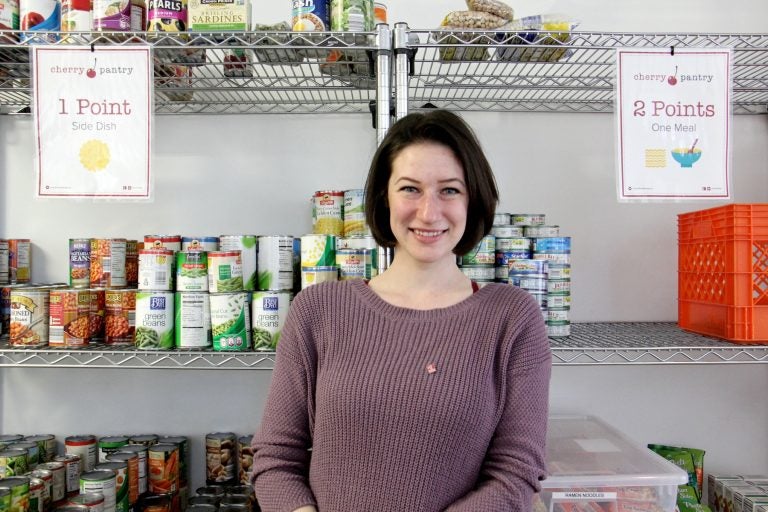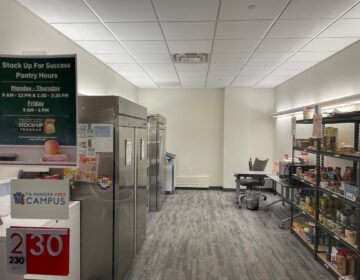Third of college students go hungry or lack housing, Temple researcher finds
A national survey of college students found 36 percent struggle to find enough to eat or have a safe place to live.

Temple senior Sarah Levine, who struggled with food insecurity herself, is the student manager of the Cherry Pantry, which she helped to create. (Emma Lee/WHYY)
Gaining the “freshman 15” used to worry students starting out at college — but many now are trying not to lose 15 pounds.
A national survey of college students found 36 percent struggle to find enough to eat or have a safe place to live.
The survey, Still Hungry and Homeless in College, conducted by Temple University and the Wisconsin HOPE Lab, polled students at 31 community colleges and 35 four-year public and private colleges and universities.
Temple professor Sara Goldrick-Rab, the lead researcher, said paying for college is exacting a toll on students that’s much more severe than people might think.
- 36 percent of university students and 42 percent of community college students were food insecure in the 30 days preceding the survey.
- 36 percent of university students and 46 percent of community college students were housing insecure in the last year.
- 9 percent of university students and 12 percent of community college students were homeless in the last year.
“People talk about tuition, or they hear about the high cost of the books,” said Goldrick-Rab. “But I don’t think they really realize that the area where many students are falling short is with regard to living expenses and the consequences of not having enough to eat or not having a safe place to live on a reliable basis.
“That can really do real harm to someone’s education whether they’re in ninth grade or whether they’re in college. It’s very serious.”
And all those issues, said Goldrick-Rab, are symptoms of larger problems.
“The things that contribute to these challenges — declines in family income and higher prices of college and the declining value of the minimum wage and the shredded safety net — those things are definitely worse today than they’ve been in the past,” she said.
Last year, about 10 percent of college students were homeless.
The survey showed these insecurities disproportionately affect students from at-risk groups, including LGBT, African-American, and Native American students, and those who grew up in foster care.
Temple University senior Sarah Levine used to frequent student events where any kind of food was served as a way to eat for the day.
“Whether it was candy, vegetables, little snack trays or even pizza, that would be a big portion of my diet. And if I got someplace, and they didn’t have any food left, well then I might not eat for the day,” the neuroscience major said.
Levine’s food and housing insecurity followed financial troubles in her sophomore year that forced her to cancel her meal plan.
‘I wasn’t just this anomaly’
Knowing how hunger affects students, Levine helped bring a food pantry to Temple. She’s student manager of the Cherry Pantry funded entirely by donations.
“The best experience I’ve actually had with the students was the first day when we opened,” said Levine, a first-generation college student. “It felt so amazing that I was able to actually recognize someone. Beyond me feeling like I could help someone, it felt like I wasn’t alone.
“I finally had like a face to the 35 percent, that I wasn’t just this anomaly,” she said.
Realizing what a difference the pantry will make for Temple students and community members, Levine said, has left her with a feeling of accomplishment.
Cedar Crest College, a women’s college in Allentown, Pennsylvania, established a resource pantry in response to students’ needs, said Mary Alice Ozechoski, vice president of student affairs and traditional enrollment.
But she agreed with Goldrick-Rab that food insecurity is rooted in a deeper problem: the rising cost of higher education.
“Students are making choices around how to manage those costs by doing things like choosing the least number of meals on a meal plan, so they have less expense,” Ozechoski said.
About 30 million U.S. students get subsidized lunch and breakfast in kindergarten through 12th grade.
“Then, they come to college and that resource isn’t there,” Ozechoski said. “So how do we expect them to be successful? Because we want to have a well-educated workforce. We have to work with college students holistically. We have to meet them where they’re at, and we have to meet their needs.”
Ozechoski is part of the Emergency Aid Lab, a national collaboration that’s creating comprehensive emergency aid programs for institutions to complement one-time funding for unexpected costs now available at many schools.
The third #RealCollege Conference on food and housing insecurity issues will be held at Temple in the fall.
The HOPE Center for College, Community and Justice, a center to help provide resources to students and confront these issues, will open at Temple in September.
WHYY is your source for fact-based, in-depth journalism and information. As a nonprofit organization, we rely on financial support from readers like you. Please give today.




